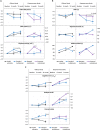Efficacy of multidomain interventions to improve physical frailty, depression and cognition: data from cluster-randomized controlled trials
- PMID: 32134208
- PMCID: PMC7296266
- DOI: 10.1002/jcsm.12534
Efficacy of multidomain interventions to improve physical frailty, depression and cognition: data from cluster-randomized controlled trials
Abstract
Background: Frailty is the pre-eminent exigency of aging. Although frailty-related impairments are preventable, and multidomain interventions appear more effective than unimodal ones, the optimal components remain uncertain.
Methods: We devised multidomain interventions against physical and cognitive decline among prefrail/frail community-dwelling ≥65-year-olds and evaluated these in complementary cluster-randomized trials of efficacy and participant empowerment. The Efficacy Study compared ~3-monthly telephone consultations vs. 16, 2 h sessions/year comprising communally partaken physical and cognitive training plus nutrition and disease education; the Empowerment Study compared the standard Efficacy Study multidomain intervention (Sessions 1-10) vs. an enhanced version redesigned to empower and motivate individual participants. Changes from baseline in physical, functional, and cognitive performance were measured after 6 and 12 months in the Efficacy Study and after 6 months in the Empowerment Study, with post-intervention follow-up at 9 months. Primary outcomes are as follows: Cardiovascular Health Study frailty score; gait speed; handgrip strength; and Montreal Cognitive Assessment (MoCA). Secondary outcomes are as follows: instrumental activities of daily living; metabolic equivalent of task (MET); depressed mood (Geriatric Depression Scale-5 ≥2); and malnutrition (Mini-Nutritional Assessment short-form ≤11). Intervention effects were analyzed using a generalized linear mixed model.
Results: Efficacy Study participants (n = 1082, 40 clusters) were 75.1 ± 6.3 years old, 68.7% women, and 64.7% prefrail/frail; analytic clusters: 19 intervention (410/549 completed) vs. 21 control (375/533 completed). Empowerment Study participants (n = 440, 14 clusters) were 75.9 ± 7.1 years old, 83.6% women, and 56.7% prefrail/frail; analytic clusters: seven intervention (209/230 completed) vs. seven control (189/210 completed). The standard and enhanced multidomain interventions both reduced frailty and significantly improved aspects of physical, functional, and cognitive performance, especially among ≥75-year-olds. Standard multidomain intervention decreased depression [odds ratio 0.56, 95% confidence interval (CI) 0.32, 0.99] and malnutrition (odds ratio 0.45, 95% CI 0.26, 0.78) by 12 months and improved concentration at Months 6 (0.23, 95% CI 0.04, 0.42) and 12 (0.46, 95% CI 0.22, 0.70). Participant empowerment augmented activity (4.67 MET/h, 95% CI 1.64, 7.69) and gait speed (0.06 m/s, 95% CI 0.00, 0.11) at 6 months, with sustained improvements in delayed recall (0.63, 95% CI 0.20, 1.06) and MoCA performance (1.29, 95% CI 0.54, 2.03), and less prevalent malnutrition (odds ratio 0.39, 95% CI 0.18, 0.84), 3 months after the intervention ceased.
Conclusions: Pragmatic multidomain intervention can diminish physical frailty, malnutrition, and depression and enhance cognitive performance among community-dwelling elders, especially ≥75-year-olds; this might supplement healthy aging policies, probably more effectively if participants are empowered.
Keywords: Cognitive; Community; Elder empowerment; Healthy aging; Malnutrition; Multidomain intervention; Outcome; Physical frailty.
© 2020 The Authors. Journal of Cachexia, Sarcopenia and Muscle published by John Wiley & Sons Ltd on behalf of Society on Sarcopenia, Cachexia and Wasting Disorders.
Conflict of interest statement
L.‐K.C., A.‐C.H., W.‐J.L., L.‐N.P., M.‐H.L., S.‐F.S., C.‐H.L., and S.‐T.C. declare no conflicts of interest. D.L.N. is a professional medical writer employed at time of writing by Full Universe Integrated Marketing Ltd., Taiwan.
Figures




References
-
- Lin MH, Chou MY, Liang CK, Peng LN, Chen LK. Population aging and its impacts: strategies of the health‐care system in Taipei. aging Res Rev 2010;9:S23–S27. - PubMed
-
- Landi F, Liperoti R, Russo A, Capoluongo E, Barillaro C, Pahor M, et al. Disability, more than multimorbidity, was predictive of mortality among older persons aged 80 years and older. J Clin Epidemiol 2010;63:752–759. - PubMed
-
- Lang PO, Michel JP, Zekry D. Frailty syndrome: a transitional state in a dynamic process. Gerontology 2009;55:539–549. - PubMed
Publication types
MeSH terms
LinkOut - more resources
Full Text Sources
Medical
Miscellaneous

